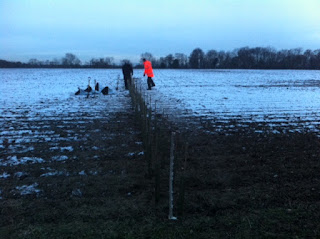There is currently an ongoing tree planting
plan on the Wimpole estate to put back the avenues and former trees that would
have been seen in the 18th Century. I can’t remember who’s landscape
plan we are referring back to; might be Bridgeman or Brown (Yes, THE Capability
Brown!). Certainly over a long-term plan of 5 – 10 years, the landscape at
Wimpole will be a fuller place.
If you’re interested in learning about the
tree histories on the estate check out the sister blog at: https://sadeik.wordpress.com/blog/wildlife/trees.
The tree planting plan itself is thanks to
the hard work undertaken by Mark who worked on the estate between 2011 and
2012, in conjunction with the conservation department in the National Trust.
With the planting plan in place and approved by those higher up, we set about
implementing the scheme that will run for the years to come.
So as not to have a big impact on the
landscape in a short period of time and to not wear out the spades and the
knees of the poor workers (i.e. us), the work has been spread out so only a
hundred or so will be planted per year.
At the start of the project in 2012, we put
in 60 trees in Folly field with mesh netting to protect them against foraging
animals. The trees we planted were a mixture of species; Oak, Ash and Horse Chestnut to name
but a few. In case you’re wondering, yes I can’t remember exactly what other
species there were. There may have been Sycamore, Lime, Maple, Hazel and a few
others but I’m not 100% certain we actually included those!
Incidentally the species were chosen for
specifically for different locations as they would have been the original type
of tree planted. Of course after we had put the 60 trees in last year, there
was the Ash disease problem occurring with European imported trees so a guy
from the Forestry Commission had to pay a visit to make sure the Ash trees we
had just planted weren’t carriers.
Fortunately all the Ashes we had delivered
were healthy and showed no signs of the disease.
 |
| View looking North(ish) |
This view across the parkland to the north
of the Hall was taken in 2008 and is a good representation of how the landscape
currently looks. I’ll take a photo in the future to show how it looks with the
new trees added. A kind of ‘then and now’ comparison.
On to 2013, and preparations for this
year’s trees (all 157 of them) are being made. Last week in the snow and ice we
were out and about marking the places where the trees will be planted.
Bramwell, a NT conservation chap, popped along with his GPS equipment and started
to plot out the locations.
While he plotted, I followed up with blue
and white stakes to mark the location while Simon finished off by hammering in
a solid wooden stake deep into the ground. Why mark the position of the tree
twice you ask? Put it this way, have you seen the kids run amok in the
countryside touching things and moving anything that isn’t welded down… yeah,
that’s why! To be fair to the children (I have a nephew of my own) it’s also
the mischief makers you have to watch out for.
We have different
coloured poles simply because of the area the trees are going to go into. Blue
for sensitive conservation locations, mainly those places where there is known,
or thought to be known archaeology under the turf. White stakes are obviously
the less sensitive areas out in the middle of the parkland were not much is
expected to turn up. Of course there is also the possibility of digging down
smack bang on top of a Roman mosaic, but that is highly unlikely judging from
the archaeological landscape.
 |
| Wimpole Hall looking East |
Speaking
of archaeological landscapes, this view of the Hall looking east has some good
examples of ridge and furrow seen in the foreground.
Ridge and furrow is the old medieval way of
farming before the landscape at Wimpole was managed and re-designed in the 18th
Century.
The furrow was used as drainage from the
main crop planted on the ridge. This was especially important with low draining
soils and helped to prevent crops becoming waterlogged in particularly wet
periods.
Of course in context with this post, the
photo also serves as a view of the front of the Hall before we begin planting
the new trees this year.
Taken in 2009, there has been no change to
the landscape since then. Apart from the smaller trees nearer the Hall, which have
metal tree guards round them now to prevent damage from stock.
The tree guards are
in keeping with the historic landscape with a similar design from the time of
Bridgeman and Brown. Same goes with the park-rail fencing seen across the
estate.
I should also point out that the old
avenues can still be seen throughout the parkland if you look close enough.
There is the walnut avenue running diagonally from the front of the Hall, and
the oak avenue to the north. Interestingly enough, apparently when the trees
and avenues were originally planned in they are located along the grid lines
seen on maps!
Since this post is
all about trees and apart from the ones within the landscape on the above
photos, there isn’t actually a picture of one. Here you go!
All of the photos are my own this time
round,
Until next time…









